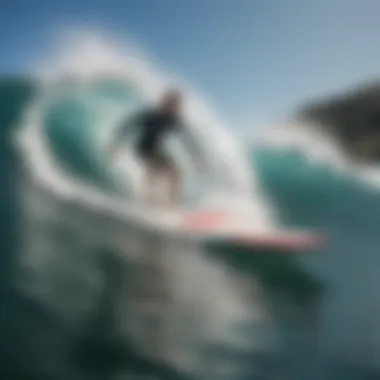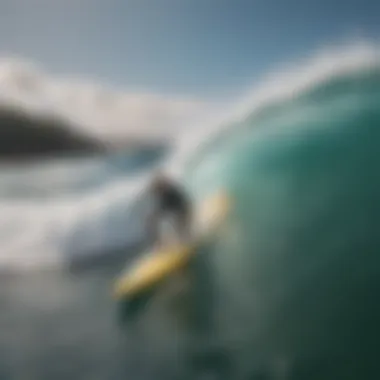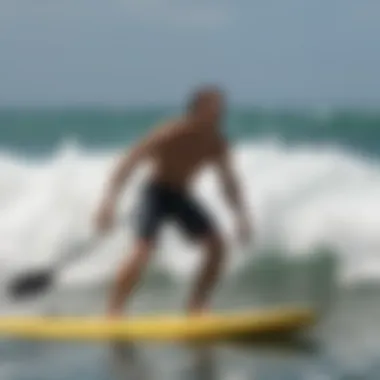The Dynamics of Paddle Competition in Surfboard Events


Intro
Paddle competitions stand at the heart of surfboard events, a unique blend of athleticism and strategy that has grown in importance over the years. It’s not merely about who can paddle the fastest; it's also about how well participants can read the ocean, position themselves for incoming waves, and exhibit tactical proficiency under pressure. This aspect of surfing has its roots going back to ancient Polynesian cultures, where paddling was both a means of transportation and a vital part of fishing.
Surfing culture is rich and multilayered, and the inclusion of paddle competitions adds another dimension to these events. As the sport evolves, so too do the techniques and equipment that surfers rely on. For the novice picking up their first board and for the seasoned pro weathering hefty swells, knowing the ins and outs of paddle competitions can be the key to unlocking their full potential on the waves. Moreover, the growth of this aspect of surfing has fostered a sense of community among surfers, promoting connections that transcend geographic boundaries.
Understanding the dynamics of paddle competition means recognizing the skill involved in effective paddling, the significance of the right gear, and the etiquette that keeps competition friendly and respectful. In the sections to come, we will explore these aspects and delve into the techniques that define paddle competition success, ultimately leading to a richer experience on the water.
Surf Gear and Equipment
In the realm of paddle competitions, equipment plays a critical role. The right gear can mean the difference between catching a wave and wiping out. Let’s break down some of the essentials.
Latest Surfboard Technologies
Surfboards have come a long way since the days of wood and fiberglass. Today's surfboards are often crafted with advanced materials like epoxy and carbon fiber, which not only reduce weight but also enhance durability.
- Epoxy Boards: Lighter and more buoyant which allow for better paddling speed.
- Carbon Fiber Reinforcements: Provide stiffness and strength, ideal for aggressive maneuvers.
- Foam-Core Boards: These offer cushion on falls, important for paddle competition settings where unexpected wipeouts can occur.
The design of surfboards is also evolving. Features like rocker lines and rail shapes can impact paddling efficiency. Modern boards may include concave bottoms, designed to make turning easier and to accelerate through various types of waves.
Essential Accessories for Surfers
While the surfboard is paramount, it’s not the only piece of gear to note. A lot of added accessories come into play, enhancing performance and ensuring safety:
- Leashes: Carrying your board back after a wipeout is essential, so a strong leash keeps your board close.
- Wetsuits: A good wetsuit can keep you warm in colder waters, allowing for longer practice sessions.
- Surf Caps and Booties: Not always thought of, but these can provide extra sun protection and traction in rocky waters.
And don't forget the hydration pack! Staying hydrated is crucial during those intense competitions.
"The right gear doesn’t just cushion your fall; it elevates your ride."
Techniques and Skills
Paddle competitions are as much about technique and skill as they are about physical ability. Knowing how to paddle effectively can significantly improve your performance.
Wave Riding Strategies
Understanding the nuances of wave riding can give a paddle competitor a leg up over others. Consider the following strategies:
- Timing Your Paddle: Synchronizing your paddle strokes with the rhythm of the waves can help in catching them more smoothly.
- Positioning: Not all spots on the line-up are created equal; knowing where to sit and how to navigate can lead to major advantages.
- Control Your Speed: Sometimes, being the fastest isn’t the best. Smooth, controlled movements can help stabilize your ride and prepare you for turns.
Safety and Surf Etiquette
In paddle competitions, safety should never take a backseat. Etiquette dictates everything from respecting the right of way to knowing when to back off a wave. Here are some crucial points to remember:
- Always respect fellow surfers on the water.
- Be aware of your surroundings, especially in crowded surf zones.
- Communicate. A simple nod or wave can go a long way in maintaining harmony in the water.
An understanding of safety measures not only protects you but ensures the whole community enjoys their ride.
The dynamics of paddle competition are intricate and multifaceted, blending the technical skills of individual surfers with the broader surfing community. This excursion into equipment, techniques, and the heart of surfing culture illustrates why these competitions are more than just physical contests; they're a celebration of the sport that ties surfers together across the globe.
Historical Context of Paddle Competition
The world of paddle competition has long been a vital thread in the fabric of surfboarding. Understanding this historical backdrop provides invaluable context, showcasing how far this sport has come and its significance in surf culture today. When delving into the origins of paddle events, one sees not only a reflection of sports evolution but also a clear mirror of the cultural shifts accompanying them. The paddle competition is more than just a race; it embodies the spirit of camaraderie and competition intrinsic to surfers.
Origins of Paddle Events
Paddle competitions can trace their roots back to ancient Polynesian cultures where ocean navigation was a critical skill for survival. These early seafarers utilized paddleboards, known as wa'a kaulua, to navigate the vast Pacific waters. Their mastery over waves and tides was not merely functional but steeped in tradition, with races serving not just as a test of skill, but as a celebration of their connection to the sea.
As the surf culture began to evolve in the early 20th century, paddleboarding emerged as a sport in its own right. Surf lifesavers introduced paddling into their training regimens, laying the groundwork for competitive events that mirrored their practical skills. It was in the warm California waters that paddle competitions started gaining traction, marking the transition from a survival skill into a sporting endeavor, and showcasing a sense of rivalry.
Evolution Through Decades


Over the decades, paddle competitions have seen significant transformations, paralleling advancements in surfboard technology and changes in cultural attitudes. The 1960s and 70s heralded a new wave of interest, coinciding with the surf rock era. With the rise of brands like Hobie and the introduction of lighter and more hydrodynamic boards, participants began pushing boundaries.
- 1970s: The introduction of synthetic materials revolutionized paddleboard design. This decade saw the establishment of formal competitions, where local enthusiasts started hosting events.
- 1980s-90s: The sport took a more structured approach, culminating in prestigious competitions like the Molokai Challenge. Here, paddlers were tested not just on their skills but their endurance against tough ocean conditions.
- 2000s onwards: Paddleboarding has seen a significant surge in popularity, with more people engaging in fitness paddling and recreational events, i.e., the emergence of Stand Up Paddleboarding is reshaping the landscape.
Despite these changes, the essence of paddle competition remains anchored in the community spirit it fosters, bridging various demographics and backgrounds.
Paddle Competition as a Surf Culture Element
Paddle competitions serve as more than mere contests; they are a cornerstone of surfing culture. At events, camaraderie flourishes, fostering bonds between competitors, families, and fans alike. They are gatherings filled with passion for the ocean, filled with shared exhilaration whether one is a participant or a spectator.
"As one races against the waves, the thrill and the community surrounding paddle events become a dance of shared experience."
The surf culture, embodying values like respect for nature, adventure, and resilience, finds rich expression in these competitive settings. With every stroke, paddlers connect with the ocean, emphasizing the importance of maintaining a balance between competition and environmental stewardship.
Techniques Employed in Paddle Competitions
Paddle competitions in surfboard events rely heavily on the techniques honed by participants. These techniques are not just about physical prowess; they integrate strategy, timing, and understanding of the environment. A surfer's ability to paddle efficiently can be the difference between catching that crucial wave or missing it altogether. Therefore, immersing oneself in the methods of effective paddling is essential for anyone looking to excel.
Fundamentals of Effective Paddling
At the heart of effective paddling lies the fundamental techniques that every surfer should master.
- Body Positioning: One’s stance on the paddleboard is key. A low, balanced position can provide stability and augment paddling power. Surfers often find that positioning their torso forward with knees bent allows for better weight distribution, making it easier to maneuver.
- Paddle Stroke: The stroke itself is a crucial consideration. Surfers usually adopt a long and smooth motion for maximum efficiency.
- Breathing Techniques: Surprisingly, breath control can play a role. Effective paddling requires a rhythm that includes coordinated breaths. Surfers tend to breathe in when their arms are recovering and exhale during the stroke, basically syncing their movements.
- Begin the stroke with the paddle fully engaged in the water, pulling through the water with strong and consistent force.
- End the stroke by lifting the paddle out gently, avoiding splashing, which can disrupt your rhythm and attract unnecessary attention from fellow competitors.
Mastering these elements gives paddlers a foundation to build on as they engage in more complex techniques later.
Advanced Paddling Techniques
Once a surfer has a grip on the fundamentals, they can branch out into advanced paddling techniques. These are often tailored to specific situations and wave conditions.
- Bracing and Recovery: Knowing how to brace oneself during turbulent conditions is vital. Surfers practice techniques like ‘high brace’ and ‘low brace’ for maintaining stability. These techniques act as a failsafe when waves throw them off balance.
- Sprint Paddling: This is akin to an athlete's finishing sprint. In competition, gaining speed quickly can help a surfer secure a prime wave before others do. This requires building short bursts of energy—using strong, sharp strokes with an explosive kick-off.
- Turning and Steering: Efficient maneuverability is essential in surf competitions. Mastering techniques for quick direction changes can avoid collisions and position a surfer for success. Quick paddle strokes on one side can pivot the board with precision, much like a finely tuned car on a race track.
Comparison of Different Styles
Not all paddling techniques are created equal. Various styles cater to different types of surf conditions and personal preferences.
- Traditional Paddling: This is the go-to method for many surfers, emphasizing streamlined, long strokes. It’s efficient for flat waters and balance-focused events.
- Sweep Paddling: This style involves a broader, arc-like movement, often used in surf zones with expansive swells. It enables surfers to cover more ground and steer effectively.
- Crossover Techniques: Some experienced paddlers develop unique styles that blend traditional and advanced methods, adapting to conditions as they arise. For competitive surfers, being flexible is invaluable; sometimes, it’s all about switching styles in the heat of the moment.
"The art of paddling is just as important as riding the waves themselves. It is the unsung hero of the surfing experience."
In sum, understanding the techniques employed in paddle competitions goes beyond just beating the competition. It encompasses a blend of body mechanics, strategic foresight, and adaptability. The ability to merge these techniques efficiently allows surfers to not only thrive but find joy in the ocean's rhythm. As this segment unfolds into the following sections, the techniques lay the groundwork for understanding the equipment and environment that shape paddle competitions.
Essential Equipment for Paddle Competitions
In the world of paddle competitions, the equipment used can either make or break a surfer’s performance. The nuances of paddleboard selection, paddle design, and appropriate wetsuits are fundamental aspects that can significantly impact a competitor's success. Understanding these elements is vital for anyone attempting to carve out a name on those waves.
Selecting the Right Paddleboard
Choosing the right paddleboard is a bit like picking the perfect pair of shoes; it needs to fit like a glove and enhance your abilities rather than hinder them. Paddleboards come in various shapes, sizes, and designs, each tailored to different styles and conditions.
A few key factors to consider when selecting a paddleboard include:
- Length and Width: Longer boards provide better straight-line speed, while shorter boards offer more maneuverability. A wider board is generally more stable, which is especially crucial for beginners.
- Construction Material: Foam boards are lightweight and easy to handle, but fiberglass boards often provide better performance in wave conditions. Choosing the right material is all about balancing weight and durability.
- Volume and Floatation: Understand your weight and how a paddleboard’s volume affects its floatation. Too little float won't support you, while too much can make for a clumsy ride.
Ultimately, trying out various boards or seeking advice from seasoned surfers can lead to finding the perfect match. It’s important to remember that no one-size-fits-all solution exists; personal preference paired with in-depth knowledge can truly enhance performance.
Importance of Paddle Design
The paddle is an extension of the surfer's physical effort, and its design directly influences how effectively one can navigate the water. Just as one wouldn’t don a dress shoe for a marathon, paddlers need to consider the paddle’s characteristics before hitting the surf.
There are two primary styles to think about:


- Blade Shape: A wider blade can provide greater thrust, helping to move forward swiftly, while a narrower one can facilitate smoother strokes. Depending on the conditions and personal technique, the shape can vary greatly in importance.
- Length and Weight: The paddle needs to be comfortable for extended use without causing strain. A longer paddle allows deeper strokes, but if it’s too long, it can complicate control.
Investing in a paddle designed specifically for paddle competitions not only boosts performance but can also minimize fatigue, allowing for improved endurance during critical moments of a race.
Wetsuits and Gear for Optimal Performance
When it comes to paddle competitions, wearing suitable gear can often make all the difference between maintaining warmth and comfort versus battling the elements. The temperature, wave conditions, and personal tolerance to cold water should dictate the choice of wetsuit. Key factors include:
- Thickness: Generally, a thicker wetsuit offers more warmth but could limit mobility. Many surfers find a compromise between warmth and flexibility that suits their style—often the choice of 3/2 mm suits for moderate conditions or 4/3 mm for colder waters.
- Fit and Flexibility: A snug fit is essential to minimize water entry but must allow enough room for movement, particularly in the shoulders and arms, which are crucial for paddling.
- Accessories: Don’t neglect essentials like booties and gloves in cold conditions, which can enhance grip and warmth during competitive events.
"Choosing the right wetsuit and gear isn’t just about comfort; it’s about confidence. You need to feel at home in the water."
Environmental Factors Impacting Paddle Competition
Understanding how the environment affects paddle competitions is crucial for both participants and organizers. Various elements like wave dynamics, weather conditions, and tides all play a significant role in shaping the competition's outcome. Moreover, as surfers become more aware of their ecological impact, the focus on sustainable practices grows. This section dissects these elements and highlights their importance in the context of paddle competitions.
Wave Dynamics and Weather Conditions
The ocean isn't just a big blue playground; it's a dynamic environment influenced by countless variable factors. Wave dynamics rely heavily on wind patterns, barometric pressure, and current systems. When the wind whips up, it can create swells that provide ideal conditions for paddlers looking to ride. Conversely, a flat sea can be every competitor's worst nightmare.
- Wind direction can turn gentle waves into steep faces, changing paddling strategies considerably.
- Weather conditions—from storms to calm days—also add complexity. A sunny day might inspire easier rides, while dark clouds can portend tricky conditions that require adaptability.
- Temperature plays a role too; cold waters might necessitate more gear, impacting stamina when racing.
Paddlers must surmount these challenges, honing skills not just to navigate waves but also to read the environment effectively.
Tide Impacts on Competition Strategy
Tides have a natural ebb and flow, but for surfers, they mean a game of strategy. Understanding how the tide interacts with local breaks can shape how competitors paddle and position themselves during the event. High tide might benefit some spots while exposing others, leading to a scramble to adapt strategies as conditions shift.
- Timing: Surfers often have to wait for the right moment to catch that perfect wave. Good timing can separate the winners from the also-rans.
- Positioning: During competitions, choosing the right spot to start from can mean everything.
- Tide shift: A sudden change in tide might require competitors to alter their approach on the fly.
A deep knowledge of tidal behavior adds an extra layer of difficulty, demanding not just physical prowess but strategic planning as well.
Environmental Consciousness in Surfing
Today’s surfers face a reality where being eco-friendly is not just a trend; it’s become a necessity. Paddle competitions can serve as platforms that inspire environmental advocacy. As waves are directly tied to climate health, many surfers now feel a responsibility to protect their playground.
- Community Initiatives: Many paddle events involve coastal clean-ups or educational workshops about ocean conservation.
- Sustainable brands: Surfers now prioritize gear manufactured from environmentally friendly materials, such as eco-friendly paddleboards or wetsuits made from recycled materials.
- Awareness: Events increasingly showcase topics around ocean health, surf traditions, and rights, teaching participants to respect nature while enjoying it.
Competing with an environmentally conscious mindset doesn’t just elevate the individual competitor but enhances the entire surf culture.
"As we surf, we must also protect the very waves we love to ride. The ocean gives, so we must learn to give back."
Understanding these environmental factors not only shapes how paddle competitions are won or lost but launches a broader conversation around sustainability. The balance between performance and respecting nature is now at the forefront of what it means to engage in paddle competitions.
Strategies for Success in Paddle Competitions
In the realm of surfboard events, paddle competitions serve as a litmus test for a participant's prowess not just in wave riding, but in both physical and mental agility. The competitive scene is fierce, and having viable strategies is paramount. It’s crucial to consider various elements that contribute to success—tailoring your approach to conditioning, mental readiness, and tactical decisions can make all the difference on that surfing battleground.
Conditioning and Fitness Strategies
Getting one’s body fighting fit is no laughing matter when it comes to paddling. Surfers who aim to reach the podium must prioritize their conditioning regimes. While the thrill of riding a wave is often spotlighted, the groundwork—the relentless training—is what sets competitors apart.
- Endurance Training: Engage in cardio exercises such as running or cycling to build stamina, allowing paddle competitors to withstand longer sessions and intense races.
- Strength Training: Focus on upper body workouts. Paddleboarding demands robust shoulders, arms, and core stability. Exercises like push-ups, pull-ups, and planks can be incredibly beneficial.
- Flexibility: Stretching routines or yoga can significantly increase flexibility, reducing injury risk while improving paddling efficiency.
For instance, a well-rounded fitness plan integrating these elements can be a game changer. It's said that a tired surfer is a slow surfer, and fatigue might just tip the scales in a competitive setting.
Mental Preparation for Competitions
While physical conditioning lays a solid foundation, the mental aspect is equally significant. Entering a paddling competition is as much about engaging the mind as it is about flexing the muscles. Competitors must cultivate a mindset geared toward focus and resilience.
- Visualization Techniques: Surfers can benefit from visualizing their performance. Picture yourself catching waves as you practice paddling. This mental rehearsal builds confidence.
- Mindfulness Practices: Consider meditative techniques to bolster concentration. Going into the competition with a calm mind can enhance performance under pressure.
- Setting Goals: Prior to the event, surfing athletes should set realistic yet challenging goals. This helps maintain motivation and gives them something to strive towards.
Paddling with a clear and determined mind can translate into sharp reflexes and strategic decisions, enabling competitors to navigate challenges with poise.


Tactical Decision Making in the Surf
Strategic thinking in the swirling currents of competition can often mean the difference between catching the wave of a lifetime or floundering in the surf. Knowing when to paddle harder or choose a specific wave can dedide outcomes.
- Wave Selection: Choose waves that align with your strengths. Whether aiming for speed or technical maneuvers, discerning the right waves early on can set the tone.
- Positioning: Stay aware of where other competitors and the best waves are. Every paddler is vying for the same window of opportunity, so until your instincts take charge, positioning can help navigate this jungle.
- Adaptability: Conditions like wind and tide can shift in a heartbeat. A successful surfer will adapt accordingly, having backups in mind.
"In a split second, the right choice can elevate your standing or sink you like a stone."
Ultimately, utilizing effective strategies in paddle competitions—combining fitness, mental acuity, and tactical wisdom—creates an environment where surfers can truly shine. A well-rounded approach not only prepares surfers for competition, but also instills a deeper connection to the sport, fostering resilience amidst the ever-changing dynamics of the ocean.
The Role of Community in Paddle Events
The community is the backbone of any paddle competition, intertwining social dynamics with the spirit of competition. This section delves into how the community enhances the paddle event experience by creating connections, promoting events, and advocating for environmental protection. Understanding this role is crucial, as it influences not just the competition itself, but also contributes to a larger culture around surfing.
Building Networks Among Surfers
Building a network among surfers is like weaving a tapestry of stories, skills, and shared experiences. These networks bring enthusiasts together, allowing them to exchange tips, techniques, and local knowledge of spots that may be off the beaten path. Whether it's through social media groups or local clubs, surfers create platforms where they can communicate and support one another, especially during competitions.
- Skill Sharing: Surfers often mentor newcomers, sharing tricks of the trade about paddling techniques and wave understanding. This exchange not only raises everyone's game but also fosters camaraderie.
- Event Attendance: When local surfers organize or participate in events together, it strengthens the bonds within the community. Joint attendance not only boosts morale but can turn an ordinary competition into a memorable gathering.
Connecting with fellow surfers also extends beyond the beach. Engaging with local businesses and organizations can create sponsorship opportunities, benefiting both competitors and the community as a whole.
Promoting Local Surfing Events
Local surfing events don’t just showcase talent; they serve as celebrations of culture, community, and fun. Promoting these events is essential in rallying support and elevating the local surf scene.
Community involvement often includes:
- Social Media Campaigns: Utilizing platforms such as Facebook and Instagram, surfers spread awareness about upcoming competitions, highlight local talent, and capture the excitement through photos and videos.
- Collaborations with Local Businesses: Partnering with surf shops, cafés, and local artisans can create a festive atmosphere around events, encouraging attendance and participation. Such collaborations not only help in promoting the event but also cultivate a sense of ownership within the local community.
As community members rally around these events, they become milestones in shared histories, building bonds that last far beyond the competition itself.
Advocacy for Environmental Protection
The paddle competition community holds tremendous potential in advocating for environmental protection, particularly because surfers have a vested interest in the health of the ocean and beaches. A robust community can catalyze collective action in several ways:
- Educational Outreach: Surfers can create awareness campaigns that educate others about the importance of ocean conservation. By spreading knowledge on issues like plastic pollution and ocean health, they can galvanize support for sustainable practices.
- Beach Clean-Ups: Organizing community beach clean-up events not only fosters a sense of responsibility but also brings surfers together for a noble cause. These initiatives can turn into regular gatherings that unite individuals in the effort to protect their cherished surf spots.
- Lobbying for Policy Changes: When a community stands together, they hold more influence. Advocacy efforts can lead to policy changes that promote environmental sustainability and protect natural resources crucial for surfing.
"Surfers have a unique connection to the ocean; it’s our responsibility to protect what we love."
The bridge between paddle competitions and community impact is significant. It fosters an ecosystem of support that uplifts local surfers while ensuring the preservation of the sport, environment, and culture as a whole. Through shared experiences and collective efforts, paddlers can enjoy the waves today and secure them for future generations.
Finale: The Future of Paddle Competition
The landscape of paddle competition is not just evolving; it feels like its heart is beating stronger as surfers across the globe rally around this thrilling aspect of surf culture. The future holds potential and promise, making it an essential consideration for anyone interested in the dynamics of paddle competition. The way we approach these events today could very well shape how they are perceived and performed tomorrow.
Trends Shaping Paddle Events
Paddle competitions are constantly influenced by the broader shifts within surf culture. Current trends include:
- Inclusivity: There is a strong push towards making paddle events more accessible. From age divisions to adaptive paddling opportunities, the aim is to welcome surfers from all walks of life.
- Sustainability: With climate change and environmental concerns becoming more pressing, paddle competitions are increasingly adopting sustainable practices. Organizers are now keen on reducing waste, using eco-friendly materials, and promoting conservation efforts, which resonates well with the surf community’s values.
- Cross-Training: Surfers are diversifying their training regimens. Integrating techniques from disciplines like stand-up paddleboarding or even competitive swimming helps improve overall paddle performance.
Integrating Technological Advances
Technology is making waves in the world of paddle competitions. Innovations in equipment and performance tracking are game-changers. We see:
- Smart Paddleboards: These boards are equipped with sensors that provide real-time feedback on speed, paddling efficiency, and even wave conditions. This tech helps competitors assess their performance in ways that were unimaginable a decade ago.
- Data Analytics: Analyzing performance data is crucial. Coaches and athletes are now using software that tracks metrics over time, allowing them to fine-tune their strategies and techniques for maximum impact.
- Live Streaming and Social Media: The way competitions are shared and consumed has transformed. With live streaming technology and the power of platforms like Facebook and Reddit, paddle events can reach a global audience, attracting new participants and teams.
Maintaining the Spirit of Surf Culture
Keeping the essence of surf culture alive while adapting to these advancements is paramount. It’s easy to get caught up in the frenzy of technology and trends, but at the core lies the spirit of community, friendship, and respect for the ocean. Surfers must remember an important piece of advice from seasoned paddlers:
"The ocean speaks in a language of its own, and we must tell it our stories through respect and passion."
To uphold this spirit:
- Community Involvement: Engaging with local surf communities fosters connections that transcend competition. Building a network that values shared experiences makes competitions more than just about winning.
- Respecting Traditions: While innovation is critical, maintaining the traditions of paddle events, such as honoring local waves and cultural narratives, is what keeps the heart of surf culture healthy and pulsating.
- Promoting Mentor Relationships: Experienced surfers sharing their wisdom with newcomers enriches the paddling community. This exchange of knowledge helps retain the authentic spirit of surfing.
In summary, the future of paddle competition looks bright with innovative prospects ahead. By embracing trends, integrating technology thoughtfully, and cherishing the essence of surf culture, paddle competitions can continue to inspire and engage new generations of surfers.















